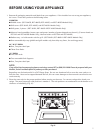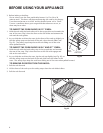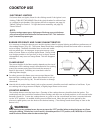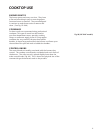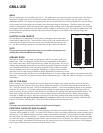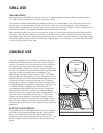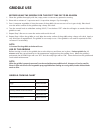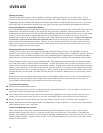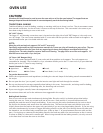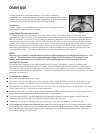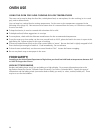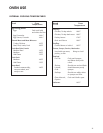
15
OVEN COOKING ELEMENTS
Your new professional RDT range is equipped with bake and broil cooking elements. The 27” oven bakes at
6,000 Watts while the 27” and 24” ovens broil at 4,000 Watts. On the RDT 305 models, the 24” oven bakes at
3,700 watts. The 12” proofing oven (RDT 48 models only) bakes at 3,700 Watts and broils at 3,600 Watts.
OVEN
Your new oven can be used in three cooking modes: convection bake, traditional bake, and regular broil. To
help you decide which way to cook your food read this information first. Remember this is a new oven and the
thermostat has been checked for accuracy. Your old oven may have had a thermostat that over the years got a
little hot or a little cold. Check your recipes for the correct time and temperature. Use caution when using your
old ovens time or temperature. You may have been compensating for your old oven being out of calibration.
Models RDT-484GG, RDT-485GD, & RDT-486GL and RDT-486GD have two ovens. The 27” oven on the right side
can be used for standard baking, fan assisted convection baking, and broiling. It is also self-cleaning. The 12”
oven on the left side, can be used for standard baking, broiling, and proofing baked goods. It is also ideal for
baking small amounts of food when you don’t want to heat the large oven.
OVEN RACKS
Models RDT-484GG, RDT-485GD, RDT-486GL and RDT-486GD have two ovens. The oven on the right side has (3)
standard racks and 4 rack positions. The left side oven has 2 oven racks and 4 roller assisted rack supports.
NOTE:
About the roller assisted rack supports (24" and 27" oven only):
Specifically engineered from high temperature materials for in oven use, they will stand up to years of use. They
are especially functional when the oven racks are supporting the heavy food products associated with this high
capacity oven. The racks should be removed before self cleaning. See page 30 for care of the rack supports. All
dual fuel ovens come with a 2-pc. broil pan.
PREHEATING
Preheating takes about 10 to 15 minutes depending on the temperature set. Preheating is usually necessary for
foods baked at high temperature for a short period of time, i.e. drop cookies. The oven heating light will turn
“Off” and the ready light will be “On” when the oven has reached temperature.
CONDENSATION
During any cooking process there is a certain amount of moisture that evaporates from the food. The amount of
moisture that condenses on the oven depends on the moisture content of the food. The moisture will condense
on any surface that is cooler than the inside of the oven, such as the control panel or the top of the door.
CAUTION!
Aluminum foil should never be used to cover the oven racks or to line the oven bottom. The trapped heat can
damage the porcelain and the heated air cannot adequately reach the food being baked.
CONVECTION BAKING
Convection baking is baking with a fan at the back of the oven circulating the hot air in a continuous pattern
around the food. This circulating hot air heats and browns the surface of the food more effectively than in a
standard oven. This allows most foods to be cooked at lower oven temperatures or in less time, if baked at the
regular temperature. The air is recirculated and reheated. Uncovered, longer cooking foods such as large
pieces of meat or other foods that can be cooked in low sided baking utensils or air leavened foods, are where
you will see the most savings in cooking time. Using multiple racks (3) at the same time will achieve a good
time saving, as you can cook more food at the same time. The number of recipes requiring preheating of the
oven is reduced considerably because the heat reaches the food faster as the hot air circulates around the food.
Foods Suitable for Convection
Appetizers
Breads
Oven Meals (1 to 3 racks)
Cookies
Main Dishes
Roasts
Pies
Poultry
Air Leavened Foods (Angel Food Cake, soufflés, cream puffs, meringue shells)
OVEN USE



